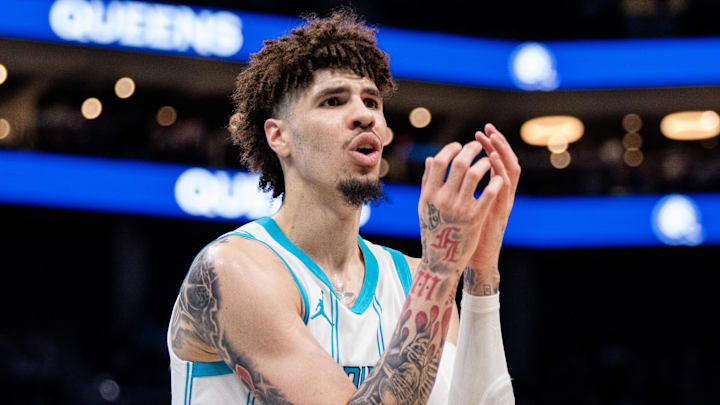The LaMelo Ball era in Charlotte has been a paradox — part highlight reel, part heartbreak. Every season brings glimpses of All-Star brilliance: no-look passes, 30-foot pull-ups, and transition wizardry that few guards can match. But it also brings injuries, inconsistency, and the lingering question that now defines the Hornets’ direction: Can you actually win big with LaMelo Ball as your best player?
It’s a fair question for a franchise still searching for relevance. Ball’s skill set is undeniable — elite court vision, creativity, and confidence — but his flaws and durability issues may cap Charlotte’s ceiling at play-in contention rather than true playoff competitiveness.
The All-Star skill set
When Ball is healthy, he’s one of the NBA’s most creative offensive engines. At 6-7, he can see over defenses and manipulate them in ways that smaller guards can’t. His assist percentage routinely clears 40 percent, and he ranks among the league’s top 10 in transition efficiency — the kind of numbers that make coaches build systems around him.
When Ball plays, Charlotte’s pace spikes, and its 3-point attempt rate jumps dramatically. The offense becomes freer, faster, and more modern. Head coach Charles Lee has praised Ball’s improved communication and leadership presence, while teammates note he’s becoming more consistent in his preparation — signs that the 23-year-old is maturing into a floor general who sets tone and tempo.
The limits of style
But Ball’s style — the same flair that makes him mesmerizing — can also be limiting. He takes an outsized number of deep, contested threes and struggles to draw fouls. His 51.1 percent finishing rate at the rim ranked near the bottom among high-usage guards last season. When those shots fall, Charlotte looks electric. When they don’t, possessions end empty, and the offense grinds to a halt.
Defensively, the story is similar. The effort has improved — there are moments of anticipation and quick hands — but he remains an inconsistent defender, vulnerable to physical guards and inattentive on closeouts. The Hornets have asked him to set the tone defensively this year, but that transformation remains a work in progress.
Ball’s trajectory mirrors other gifted playmakers — pre-trade Trae Young or late-career Kyrie Irving without elite help — players good enough to make teams relevant but not transformative without a co-star.
Durability and the ceiling problem
More than anything, availability defines Ball’s impact. Over the past three seasons, he’s played just 105 of 246 games, derailing Charlotte’s ability to build continuity or chemistry. When he’s out, the team’s net rating plummets by more than 11 points per 100 possessions, an enormous swing for any player.
A healthy Ball for 60 or more games likely means play-in contention. Anything less, and Charlotte falls into the familiar lottery pattern. It’s not just about production — it’s about reliability, and right now, that’s the biggest question surrounding both Ball and the franchise.
Supporting cast: not enough to offset the flaws
The Hornets’ roster isn’t without intrigue — Brandon Miller looks like a future star, and rookies Kon Knueppel and Ryan Kalkbrenner fit long-term rotation roles. But the supporting cast lacks a second elite option. The center rotation (Moussa Diabate, Kalkbrenner, and Mason Plumlee) is functional but limited, and while Collin Sexton adds stability, he doesn't move the needle on ceiling outcomes.
Without another star, Charlotte remains dependent on Ball’s brilliance — and vulnerable to his inefficiency.
The realistic ceiling
The Hornets’ best-case scenario with Ball leading the way? A 38–42 win season, fighting for the seventh to ninth seed, with him earning another All-Star nod and the offense ranking near league average. The more realistic outcome is closer to 30-34 wins and a 10th-seed battle that fades late due to injuries or defensive lapses.
Ball is too talented to anchor a bottom-five team but too flawed — in health, shot selection, and defense — to lift Charlotte into contention on his own. His presence guarantees excitement and relevance, but not necessarily wins.
At some point, the Hornets will have to answer the question their metrics have already begun to ask: Is LaMelo Ball’s brilliance enough to build around, or is he the piece that needs a partner to finally unlock Charlotte’s potential?
